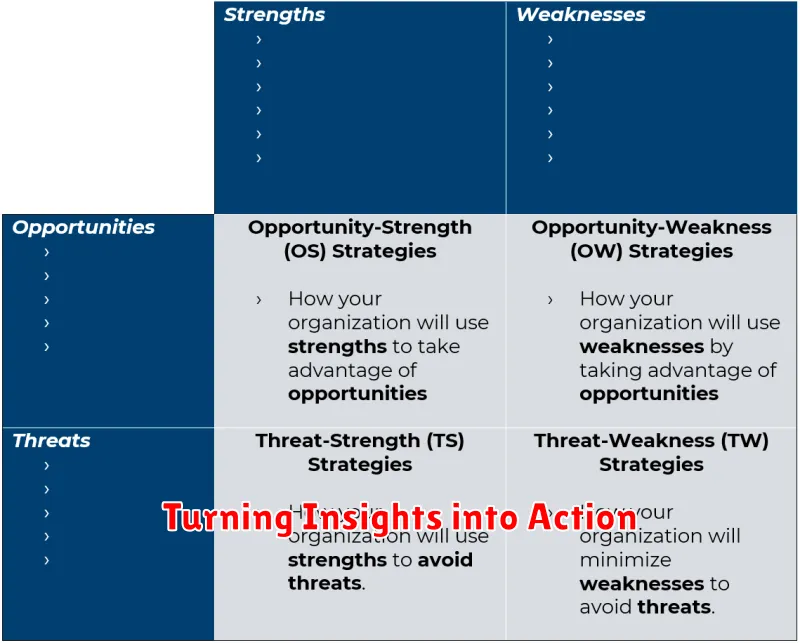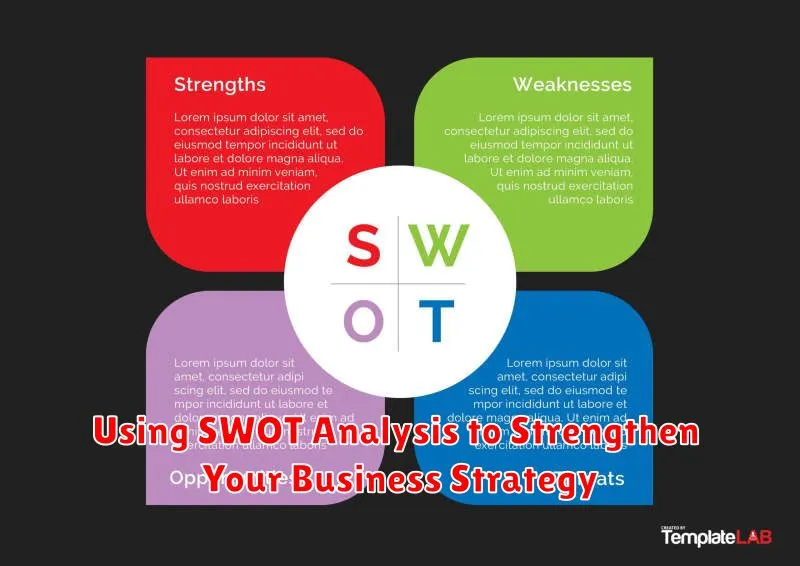In today’s dynamic business environment, a robust strategy is crucial for success. SWOT analysis provides a powerful framework to evaluate your company’s current position and identify opportunities for growth. By systematically assessing your Strengths, Weaknesses, Opportunities, and Threats, you can develop a targeted strategy that leverages your advantages, addresses vulnerabilities, capitalizes on opportunities, and mitigates potential risks. This comprehensive approach empowers you to make informed decisions, optimize resource allocation, and enhance your competitive advantage.
This article explores the practical application of SWOT analysis in strengthening your business strategy. It will guide you through the process of conducting a thorough SWOT analysis, from identifying internal strengths and weaknesses to analyzing external opportunities and threats. We will delve into how to effectively leverage the insights gained from your analysis to formulate actionable strategies that drive growth, improve operational efficiency, and enhance long-term sustainability. Whether you are a seasoned entrepreneur or just starting your business journey, understanding and utilizing SWOT analysis is an essential step towards achieving your business objectives.
What Is a SWOT Analysis?
A SWOT analysis is a strategic planning technique used to evaluate the strengths, weaknesses, opportunities, and threats involved in a project or in a business venture. It involves specifying the objective of the business venture or project and identifying the internal and external factors that are favorable and unfavorable to achieve that objective.
The internal factors are your strengths and weaknesses. These are the resources and capabilities readily available to you. External factors are opportunities and threats presented by the external environment. These are elements your business doesn’t control.
A SWOT analysis can offer helpful perspectives at different stages of a project. It can help in brainstorming new initiatives or examining problems with an existing business. It can also help prioritize efforts and resources.
Identifying Strengths Internally
Identifying internal strengths is a crucial step in SWOT analysis. This involves recognizing what your business does well and what advantages it holds over competitors. This requires an honest and objective assessment of your resources, capabilities, and processes.
Consider areas such as: unique products or services, efficient operations, strong brand reputation, skilled workforce, innovative technology, and effective marketing strategies.
Listing these strengths provides a foundation for building a strong business strategy that capitalizes on your advantages. It also helps identify areas where these strengths can be further leveraged for growth and competitive advantage.
Recognizing Operational Weaknesses
Identifying operational weaknesses is a crucial aspect of SWOT analysis. This involves critically examining internal factors that hinder your business’s performance. Weaknesses represent areas needing improvement or posing potential threats to success. They are internal deficiencies that put you at a disadvantage compared to competitors.
Consider areas like inefficient processes, outdated technology, lack of skilled personnel, or limited resources. Analyzing weaknesses helps you understand what’s holding your business back and prioritize areas for strategic intervention.
Examples of operational weaknesses could include:
- High production costs: Leading to lower profit margins compared to competitors.
- Supply chain vulnerabilities: Dependence on a single supplier or unreliable logistics.
- Poor customer service: Leading to negative reviews and decreased customer loyalty.
Exploring Market Opportunities

A SWOT analysis helps uncover potential market opportunities that your business can leverage for growth. This involves identifying favorable external factors that can give your business a competitive advantage. Opportunities represent potential areas for expansion, increased profitability, and enhanced market share.
Consider factors such as:
- Emerging markets: Are there untapped customer segments or geographic areas?
- Technological advancements: Can new technologies improve your products or services?
- Weakening competitors: Are there opportunities to gain market share from struggling rivals?
- Deregulation: Have recent policy changes created new opportunities?
- Changing consumer preferences: Can you adapt to shifting demands and trends?
By carefully evaluating market opportunities, you can make informed decisions about where to invest resources and how to position your business for future success.
Mitigating External Threats
A SWOT analysis helps identify external threats that could negatively impact your business. Mitigating these threats is crucial for long-term success. This involves developing strategies to minimize their potential impact.
Begin by prioritizing the identified threats based on their potential impact and likelihood of occurrence. Focus on developing actionable plans for the most significant threats. These plans should outline specific steps to be taken, resources required, and assigned responsibilities.
Examples of mitigation strategies include developing alternative supplier relationships to address supply chain vulnerabilities, investing in research and development to counter emerging technologies, or implementing robust security measures to protect against cyber threats.
SWOT in Strategic Decision-Making
SWOT analysis plays a crucial role in strategic decision-making by providing a structured framework for evaluating internal strengths and weaknesses, alongside external opportunities and threats.
By clearly identifying these factors, businesses can make more informed decisions about resource allocation, market positioning, and competitive strategy. This analysis facilitates the development of strategies that capitalize on strengths, address weaknesses, exploit opportunities, and mitigate threats.
Ultimately, integrating SWOT analysis into the decision-making process allows organizations to align their actions with their overall strategic goals and enhance their chances of success.
Applying SWOT to Product Launches
Launching a new product is inherently risky. A SWOT analysis provides a structured approach to assessing the potential for success. By analyzing strengths, weaknesses, opportunities, and threats, businesses can make informed decisions about product development and marketing.
Analyzing internal factors, such as your company’s strengths (e.g., brand recognition, distribution network) and weaknesses (e.g., limited marketing budget, production capacity) provides a crucial foundation. Simultaneously, evaluating external factors like market opportunities (e.g., unmet customer needs, emerging trends) and threats (e.g., competitor activities, regulatory changes) allows for proactive planning and mitigation strategies.
Common Mistakes to Avoid
While SWOT analysis is a powerful tool, its effectiveness hinges on proper execution. Avoid these common pitfalls to ensure accurate and insightful results.
Oversimplification and Lack of Specificity
Listing generic strengths, weaknesses, opportunities, and threats diminishes the analysis’s value. Be specific and provide concrete examples to gain a truly actionable understanding of your business landscape.
Ignoring the External Environment
A SWOT analysis isn’t solely about internal reflection. External factors, like market trends and competitor activities, are crucial to identifying realistic opportunities and threats.
Failing to Prioritize
Don’t treat all factors equally. Prioritize your SWOT elements based on their potential impact and your ability to influence them. This focus enables more strategic decision-making.
Collaborative SWOT Workshops
Facilitated workshops are a highly effective method for conducting SWOT analyses. Bringing diverse perspectives together fosters a richer understanding of the organization’s internal and external landscape.
Key advantages of this approach include increased buy-in from participants, a more comprehensive analysis due to varied viewpoints, and stimulated creativity for generating strategic options.
A well-structured workshop should include designated time for brainstorming each SWOT element, followed by a period of discussion and prioritization. This collaborative process helps to ensure that the resulting SWOT analysis is robust and actionable.
Turning Insights into Action

A SWOT analysis isn’t valuable unless it leads to tangible changes. Turning insights into action is the crucial final step. This involves developing strategies to capitalize on strengths, address weaknesses, exploit opportunities, and mitigate threats.
Prioritize actions based on their potential impact and feasibility. Develop clear, measurable, achievable, relevant, and time-bound (SMART) goals. Assign responsibilities and allocate resources effectively. Regularly monitor progress and adjust strategies as needed.

